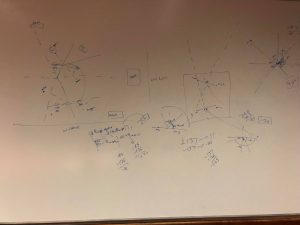Will’s Status Update 11/22
This week saw some good progress on the software side. Most of this was done with pair-programming with Ram.
- Input audio form correction. Previously each mic input was biased from 0 by a certain amount. We adjusted each audio waveform such that it is centered around 0. This means that as far as the acousticSL library is concerned, the audio activation level would be consistent for all waveforms (i.e no 1 waveform is arbitrarily larger or smaller than the other).
- Integrated the 4 microphones into acousticSL (through multiple library and callback instantiations). We also derived an ad-hoc implementation for reconciling the output angles of TDOA on two pairs of microphones into a single output angle (through a mix of adjusting to a common reference angle and then taking the measurements that are consistent from both microphones). The ad-hoc implementation is taken with reference to a parallel line going through one of the mics so this further refinement.
- Augmented the square sums smoothing for both the raw input angles and also the converged angle from multiple measurements.
- Rough latency test is promising; precision test is still worrisome
To-Dos for this week:
- Robustness to noise and adjustments for precision (at least get to 30 degrees for the OLED screen)
- Increasing the sampling frequency; balancing smoothing and latency (i.e how much to smooth, how long to smooth)
- Add a third pair of mics (possibly adjust the physical arrangement) to improve angle resolution
- Move data processing logic gradually into callbacks — this might allow us to be more lock-step when interacting with acousticSL
Some geometry of interest:
